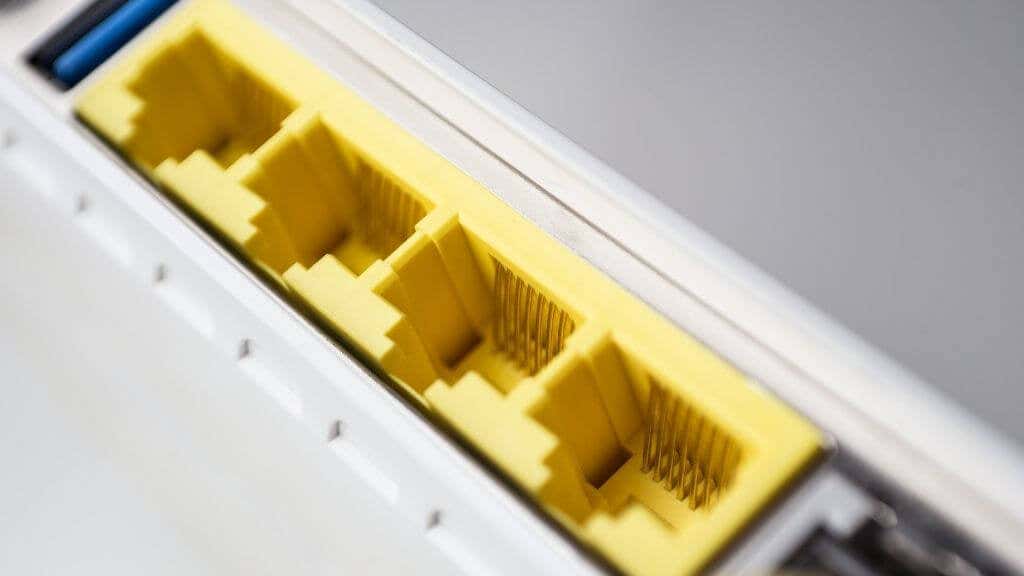A Note on Custom Router Firmware
Many of the cool things you can do with an old router depend on custom firmware. “Firmware” is the hard-wired software on the system that can only be altered by “reflashing” the memory. Every router manufacturer decides what features should be enabled in the firmware, so even if your router’s hardware is capable of something, the factory firmware may switch it off. By installing custom firmware, you can unlock all your router’s features without being forced to buy a more expensive model. Sadly, not every model of the router can use custom firmware. Check the router database for DD-WRT and OpenWRT to see if your old router is compatible.
1. Use It for LAN Gaming!
Everyone’s into online multiplayer over the internet, but there’s still nothing like sitting in a room full of friends and having a good old LAN party. Most routers have between four and six ethernet ports, so it’s simply a matter of plugging every system into the router with an Ethernet cable, and you should be ready to go. Some modern games won’t let you LAN without an internet connection, but this is the ultimate way to play over a network for the many current and classic games that let you. No lag, no excuses.
2. Use It for Extra Ethernet Ports
You can use your second router as a way to expand the number of Ethernet ports you have available. There’s some prep work involved in turning your old router into a simple network switch. Some routers make it easy by having a mode toggle in the firmware. You may also gain access to the necessary features using custom firmware. If you want to manually tweak your router to act as a switch, you’ll have to give it a specific IP address that doesn’t conflict with the primary router. Then, turn off WiFi and disable DHCP so that the master router alone can assign IP addresses. You’ll have to spend a few minutes on Google to figure it out, but it’s worth the expenditure and waste you avoid by buying a switch when the old router will do.
3. Use an Old Router as an Access Point
An access point is a way to extend the internet connection from your primary router to another device that acts as a WiFi hotspot with its SSID. One key advantage of an access point configuration is that devices connected to the second router can’t talk to devices connected to the primary router. So it’s perfect for sharing an internet connection with, for example, a room or flatlet that’s being rented out. It’s also an easy way to give internet access to far-flung devices that only need an internet connection, such as a smart TV. Generally, it’s not hard to set up an access point. Just put the two routers in place, connect them with a length of ethernet cable and configure the second router to access point mode in its settings.
4. Guest Wi-Fi Access
Using your second router as an access point is a great idea, but you still need to password protect the WiFi so that passers-by can’t rummage around all the other devices connected to it. If you want to offer WiFi to people without a password, you can switch on Guest Mode in the router’s settings. While in guest mode, each person connected to the router can only access the internet, and everything else is locked down.
5. Turn It Into a Wireless Repeater
So far, we’ve talked about connecting two routers using an ethernet cable, but what about connecting them using WiFi? Depending on whether your router supports it, you can set the second router to use Wireless Bridge mode or Wireless Repeater mode, depending on the specific language used. This will let you expand your WiFi footprint in much the same way as a dedicated off-the-shelf WiFi repeater works. You also have the same limitations, of course, such as only getting half the bandwidth through the repeater and being limited to whatever frequency bands the old router supports. For more information, check out How to Use a Spare Router as a Wifi Extender.
6. Turn It Into a NAS
Network-Attached Storage devices can be pretty expensive, but if your old router has a USB port and can accept custom firmware, you can turn it into a NAS. This involves loading custom firmware, then attaching an external hard drive to the router via its USB port. Following that, you’ll head to the NAS section of the custom firmware. For example, DD-WRT has a NAS tab where you’ll set it all up. Complete the information there, save it and apply. Then you should have a NAS visible on your network! The exact process will differ depending on your router. Some routers already have NAS functionality in their factory firmware so that you can skip that part of the process.
7. Use It as a Dedicated VPN
A Virtual Private Network is a great way to protect your privacy and unblock geo-restricted content. However, you usually don’t want to run all of your web traffic through the VPN all the time. For example, your bank will think it’s pretty weird that you’re logging in from another country. There are a few ways around this issue, but one of them is to set up your old router as an access point with a VPN configured. This way, any devices that connect to the second router are using the VPN, and those who connect to the prime router aren’t. The bad news is that older and cheaper routers cannot run VPN software, and even if they support custom firmware, the VPN function may not work due to low-performance hardware in the old router. However, it’s worth a shot to see if your old router can do the job or not.
8. Turn It Into a Basic Web Server
Another cool thing you can do with an old router (assuming it has firmware support) is to use it as a basic web server. All that means is that it hosts web content that you’ve created or copied from somewhere else. Your own little website could be something that you run only on the local network, or you can put it out on the web for anyone to use. If you’ve dreamt of starting your blog, for example, you could host your own WordPress site. It’s perhaps not the most practical use since your poor little router won’t stand up to any real traffic, but it’s a cool way to learn the ins and outs of creating and running a webserver without any actual expense.
Taking the Right Route
There are, of course, many other potential uses for an old router, and we invite you to share your creativity in the comments below. What have you done with your old router?






